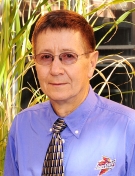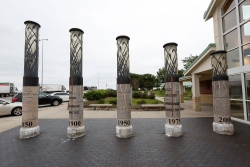Reprinted with permission from
The Leopold Center for Sustainable Agriculture
By LAURA MILLER, Newsletter editor
and JERI NEAL, Ecology Initiative Leader

Rick Cruse is getting used to hearing a collective gasp about two-thirds of the way through his presentations these days. Cruse, who directs the Iowa Water Center and is Professor of Agronomy at Iowa State University, has made it his mission to share some startling information about soil erosion in Iowa.
His message is two-fold:
- We’re losing much more soil than we think because not all types of erosion are part of the models that estimate soil loss.
- If you want to keep soil in place, you’re not going to do it by growing only corn and soybeans, no matter how many conservation practices you use.
Cruse is part of the Iowa Daily Erosion Project (DEP), a team of scientists from ISU, the National Soil Erosion Research Lab, the USDA-ARS National Laboratory for Agriculture and the Environment, the University of Iowa and Colorado State University. The team uses remotely sensed rainfall and soil and crop management practices, a web-based soil database and modeling to calculate daily estimates of rainfall, runoff and soil erosion in every HUC 12 watershed in Iowa (subwatersheds that are 15-62 square miles in size). For the past three years the team has been working to provide more sophisticated estimates that incorporate data from 230,000 LiDAR-scanned and georeferenced Iowa hillslopes.
The Leopold Center was interested in answering a question not addressed in the larger project: What has been the impact — in terms of dollars of lost yield – of soil erosion in Iowa?
To answer this question, Cruse set up a research project that included seven farms, representing each of Iowa’s Major Land Resource Areas. Each farm had a six-year cropping history with corn and soybean yield maps, and similar management practices. Locations also were selected based on locally available high-quality rainfall records.
For each field in the study, at least 45 georeferenced soil cores were obtained to determine topsoil depth and soil organic carbon. Soil cores were taken across different erosion classes and within well-drained areas.
Those sampling points were paired with cells in each field’s yield monitor maps, so that the information could be plotted on a graph to show both topsoil depth and yield (three corn and three soybean years for a corn-soybean rotation and six corn years for a corn-corn rotation).
The resulting curves on the graph show how changes in soil quality (in terms of topsoil depth) affect crop yields on seven Iowa farms.
Next, Cruse looked at soil erosion loss estimates from the National Resources Inventory, a survey conducted every 5-7 years since 1977 by the USDA’s Natural Resources Conservation Service. The calculations use a conservative estimate of 5.5 tons per year per acre for cropland in Iowa, resulting in a total average loss of 6.8 inches of topsoil in Iowa since 1850.
So what’s the impact of that loss on actual yields?
Cruse went back to the data collected from those seven Iowa farms, calculating yield based on a topsoil thinning of 6.8 inches. Results varied from no change in selected fields to 11, 18 and even 29 bushels lost yield per acre for corn. He says that a modest estimate would be an average of 10 bushels per acre yield loss from the 6.8 inches of soil erosion that has occurred in Iowa since about 1850.
“If you look at those figures and the amount of corn acres in Iowa, you quickly surpass a billion dollars of annual lost revenue,” Cruse says. “And this is a very conservative estimate.”
He estimates that about 30 percent of topsoil is lost in ephemeral gullies, those channels created in fields after heavy rainfall, especially before and shortly after annual crops are planted in spring. Soil loss equation models used by the Iowa Daily Erosion Project and the Natural Resources Inventory do not include loss from ephemeral gullies.
The surprise for most audiences, he adds, is the very slow process required to develop new soils.
“The best science indicates that we can redevelop soil at a rate of only a half-ton per acre per year,” Cruse explains. “You’re converting raw parent materials, which in the subsoil includes silica and feldspar and other substances, into biologically active materials. Erosion also can remove minerals that are the product of centuries of weathering and other processes.”

Cruse points out that most agencies use 5 tons per acre per year – 10 times the replacement rate – as an acceptable level of soil loss. Adding organic matter helps, but it does not match the productive capacity of the original, uneroded soil. In further clarifying this concept, he likes to share the following analogy.
“It’s like a football coach who has a star quarterback who injures his ankle,” Cruse explains. “The coach has two choices – tape up the ankle or put in a second-string quarterback with less experience. Either option will not give you the same performance as the original quarterback, which is what you have you try to rebuild eroded soil with soil organic matter, but replacing minerals is a very long-term proposition.”
He points to cover crops, no-till, terraces, grassed waterways and any number of practices that contribute to soil conservation in row-cropping enterprises. He emphasizes that some landscapes are sustainable only under an agronomic system that includes perennial crops – trees, prairie and pasture.
Numbers in this article were prepared as part of a one-year competitive research grant, Economic Impacts of Soil Erosion in Iowa, awarded by the Leopold Center Ecology Initiative in 2014. Cruse was principal investigator and worked with Mack Shelley, ISU Professor of Statistics; Lee Burras, ISU Professor of Agronomy; John Tyndall, ISU Associate Professor of Natural Resource Ecology and Management; and Melissa Miller, Program Coordinator, Iowa Water Center.
 4Rs… More Than Just a Nice Slogan
4Rs… More Than Just a Nice Slogan
And the cost is bore by various stakeholders, at various locations, at various times – making the solution exponentially difficult.
Tim,
I agree. As you know, assigning costs has has always been a challenge for calculating the benefits conservation practices. However, in this case, I think the cost that Dr. Cruse is referring is only in lost yields, which should be attributed to the farmers.
Interesting study. Does Richard have a publication to cite for this research yet? Thank you.
John, to date, I don’t think Dr. Cruse has any published articles on this data. My understanding is that he is working on a publication. But it would be best to contact him directly for more information.
Hi Tom Buman,
Thank you for sharing your article. It’s quite interesting. Keep on posting!